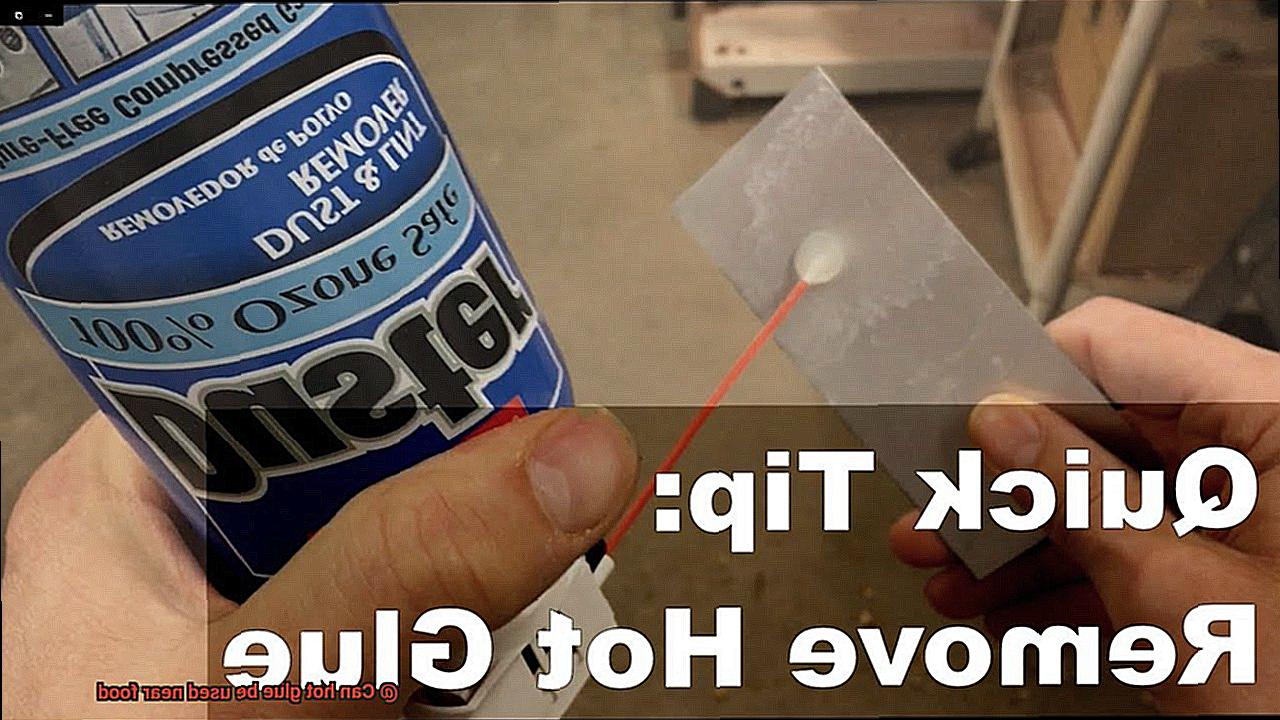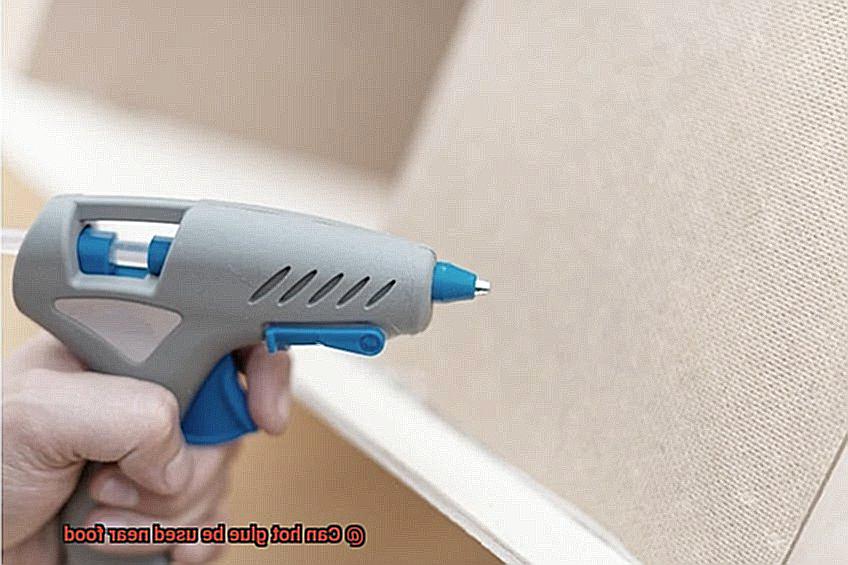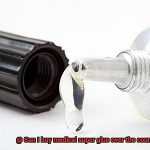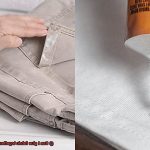Today, we’re tackling a question that might have you scratching your head: can hot glue be used near food? We all know how handy hot glue is for our craft projects, but when it comes to the kitchen, should we proceed with caution or run for the hills?
Now, we all adore hot glue for its incredible adhesive power. It’s like a superhero that bonds materials in the blink of an eye. But when it comes to our delicious creations, we need to be extra careful. So let’s take a moment to simmer down and uncover the truth about using hot glue near food.
In this blog post, we’ll explore the potential risks of using hot glue in food-related endeavors and unveil some safer alternatives. But before we dig into those practical tips, let’s get up close and personal with hot glue itself.
Get ready as we unravel the mysteries behind hot glue and determine whether it’s a trustworthy ally or a sneaky foe in the realm of food. Trust us, you won’t want to miss out on these mouthwatering insights. So grab yourself a snack and let’s dive right in.
What is Hot Glue?
Contents
With its exceptional versatility and rapid bonding properties, hot glue has revolutionized the way we create and repair. In this article, we will delve into the world of hot glue, exploring its uses, benefits, safety precautions, and its compatibility with food-related projects.
Versatility:
Hot glue stands as the adhesive of choice for a diverse array of materials including wood, metal, fabric, plastic, and ceramics. Crafters and DIY enthusiasts rely on hot glue to deliver a sturdy bond that endures everyday wear and tear. Its ability to fill minute gaps between surfaces makes it perfect for bonding uneven or irregular materials.
Quick Bonding Properties:
One of the standout features of hot glue is its high initial tackiness, allowing it to form a robust bond almost instantly after application. This characteristic empowers crafters to work efficiently and complete projects in record time. However, it is important to note that hot glue may not be suitable for long-term durability or exposure to extreme conditions.
Safety Considerations:
While hot glue is generally safe to use, caution must be exercised due to its high temperature during melting and application. To prevent burns, always employ protective measures such as gloves and avoid contact with the nozzle. Additionally, it is crucial to keep hot glue away from children and pets to prevent accidents.
Can Hot Glue Be Used Near Food?

Using hot glue near food necessitates careful consideration. Chemical migration can occur when the high temperatures of melted hot glue cause certain chemicals to leach out, potentially contaminating food items. To ensure safety, it is imperative to use food-grade hot glue specifically crafted for this purpose. These glues are composed of ingredients rigorously tested and approved for contact with food. When in doubt, opt for alternative adhesives explicitly labeled as safe for use with food.
Potential Risks of Using Hot Glue Near Food
Let’s dive into the nitty-gritty details. Hot glue is typically made from thermoplastic polymers like ethylene-vinyl acetate or polyamide. These materials are not intended to come into contact with food. In fact, they may contain additives such as plasticizers or solvents that can seep into your meal and cause trouble.
The main concern here is chemical migration. Imagine those chemicals from the hot glue making their way into your food either through direct contact or by vaporizing and condensing onto nearby surfaces. It’s not a pretty picture, is it? Ingesting harmful chemicals is a recipe for disaster, quite literally.
But wait, there’s more. Hot glue sticks are solid at room temperature but transform into a liquid state when heated. Now imagine a rogue piece of hot glue accidentally finding its way into your dish or onto your utensil. It could become a choking hazard or worse, lead to injury if ingested. Definitely not the kind of surprise we want when we’re trying to enjoy a delicious meal.
And let’s not forget about those strict regulations in professional settings like commercial kitchens or restaurants. Food safety standards exist for a reason, my friends. Using non-food-grade hot glue in these environments could land you in serious legal trouble. Compliance is key.
To sum it all up, using hot glue near food is like playing with fire (another pun intended). The potential risks of chemical migration, physical contamination, and legal consequences far outweigh any convenience or short-term benefits. It’s best to explore alternative methods or seek out adhesives specifically designed for food-related applications. Let’s keep our culinary creations safe and scrumptious, shall we?
Chemical Migration and Contamination Concerns
When it comes to using hot glue near food, it’s important to be aware of the potential risks associated with chemical migration and contamination. Hot glue, like any other adhesive, is made up of various compounds that could potentially seep into your food and cause health risks.
One concern with hot glue is the presence of harmful chemicals such as formaldehyde and volatile organic compounds (VOCs). These substances can be found in hot glue and are known to cause respiratory issues, eye irritation, and even headaches. Not exactly the kind of seasoning you want on your plate.
Another potential issue is the trace amounts of heavy metals that hot glue may contain, such as lead or cadmium. Ingesting even small amounts of these heavy metals can have serious consequences for your health.
To minimize the risks, it’s important to take some precautions. First, opt for glues that are specifically labeled as food-safe or FDA-approved. These glues have undergone testing and meet strict safety standards to ensure they won’t contaminate your culinary creations.
Additionally, it’s best to use hot glue on surfaces that don’t come into direct contact with food. If you’re attaching decorations to a cake stand or creating a centerpiece for your dining table, make sure there’s a barrier between the glue and the food itself. A food-safe liner or wrap can do the trick.
Lastly, always follow the manufacturer’s instructions and guidelines. Pay attention to temperature limits and application methods to reduce the chances of chemical migration.
Additives in Hot Glue
Beyond their ability to bond surfaces together, hot glue sticks contain additives that enhance their performance. Let’s delve into the world of hot glue additives and uncover their secrets.
The main components of hot glue sticks are thermoplastic polymers like ethylene-vinyl acetate (EVA) or polyamide. These polymers provide the adhesive properties that make hot glue so effective. However, they are not the only ingredients in the mix. Additives are incorporated to further enhance the glue’s performance.
One common additive found in hot glue sticks is a tackifying resin. This resin strengthens and adds flexibility to the glue once it dries. It ensures that hot glue bonds firmly to various surfaces, such as fabric and wood. While tackifying resins are generally safe, their composition can vary depending on the manufacturer.
Another important additive is the plasticizer. Plasticizers are responsible for making hot glue flexible and durable after it solidifies. They prevent the glue from becoming brittle over time and enable it to withstand bending and stretching without cracking. However, some plasticizers may be toxic if ingested, so caution is necessary.
Colorants or pigments are also added to hot glue sticks to create a wide range of vibrant colors. While these colorants are generally safe for crafting purposes, not all of them are food-grade. This means that they may not be suitable for direct contact with food.
To ensure safety when using hot glue near food, it is crucial to avoid applying the glue directly onto surfaces that will come into contact with food, such as plates or utensils. Instead, use a protective barrier like wax paper or parchment paper between the hot glue and the food-contact surface.
Is Hot Glue Food Safe?
Now, we’re going to address a burning question that often arises when using hot glue near food: Is hot glue food safe? While hot glue sticks are generally considered safe for general use, caution should be exercised when using them on surfaces that directly interact with your tasty treats. So, let’s dive into the research and uncover the potential risks associated with hot glue and food.
Hot glue sticks are typically made from non-toxic materials like ethylene-vinyl acetate (EVA) or polyamide, which are considered safe for general use. However, it’s the additives and chemicals present in the adhesive that raise concerns. These additives have the potential to leach into the food and cause harm if ingested. Yikes.
But before you start panicking, let’s talk about hot glue sticks that are labeled as “food-safe” or “FDA-approved.” These sticks have undergone testing and are deemed safe for direct contact with food. They’re commonly used in industries involving food packaging or processing. However, even with these labels, it’s important to remember that they should only be used on surfaces that won’t come into direct contact with the food itself.
When it comes to attaching decorations inside a cake or sealing a container for storing food, it’s best to steer clear of hot glue. Ingesting hot glue or its components can lead to gastrointestinal issues like nausea, vomiting, and diarrhea. Nobody wants that.
To ensure safety, opt for other food-safe adhesives specifically designed for attaching decorations to cakes or other edible items. Food-grade adhesives like icing or fondant are more suitable for these projects. If you absolutely must use hot glue near food, make sure it is fully cured and cooled before it comes into contact with any food. This helps minimize the risk of any residual chemicals transferring onto your delicious creations.
Benefits of Using Food-Grade Hot Glue
Food-grade hot glue is a game-changer for crafters and foodies alike. When it comes to DIY projects or decorating delicious treats, we need an adhesive that is both reliable and safe. That’s where food-grade hot glue comes in. This special adhesive is formulated to meet strict standards set by regulatory bodies like the FDA, ensuring that it is safe for use in food-related applications.
The first and most important benefit of using food-grade hot glue is its non-toxic nature. Unlike regular hot glue, which may contain harmful additives or chemicals, food-grade hot glue is made from ingredients that are safe for consumption. This means you can use it without worrying about any unwanted substances seeping into your food.
But safety isn’t the only advantage of food-grade hot glue. It also boasts impressive heat resistance. Designed to withstand the high temperatures commonly encountered in food processing and packaging, this adhesive won’t melt or degrade when exposed to heat. So go ahead and confidently seal or close your food containers without worrying about the glue losing its grip.
Speaking of grip, food-grade hot glue offers superior adhesion properties. It forms a strong and durable bond between different materials, ensuring that your packaging remains secure throughout transportation and storage. No more anxieties about compromised packaging leading to contamination or spoilage of your precious goodies.
And here’s the icing on the cake – food-grade hot glue is often odorless and tasteless. You won’t have to worry about any strange smells or flavors infiltrating your culinary creations. Whether you’re baking up a storm or packaging delicate confections, this adhesive won’t affect the sensory qualities of your food. Your treats will look as good as they taste.
Not only does using food-grade hot glue benefit you and your delicious creations, but it also helps manufacturers and businesses comply with regulations. By incorporating an approved adhesive into their processes, they can demonstrate their commitment to producing safe and hygienic products. This builds trust and confidence in their brand, which is essential in today’s discerning market.
Alternatives to Hot Glue for Use Near Food
We’ve delved into the research and compiled a list of fantastic options that will keep your food safe and your crafts intact.
- Food-grade silicone adhesive: This adhesive is specifically designed for applications that involve direct contact with food. It’s non-toxic, FDA-approved, and can withstand high temperatures without leaching any harmful chemicals into your dishes. Use it to secure decorations or attach labels to food containers without any worries.
- Double-sided tape: If you’re seeking a quick and easy option, double-sided tape is your go-to. It’s widely available, doesn’t contain any harmful chemicals, and is perfect for securing lightweight decorations or labels onto food packaging. Just bear in mind that it may not be as strong or durable as hot glue, so it’s best for temporary or lighter applications.
- Stainless steel clips or fasteners: For more heavy-duty projects like assembling cake stands or constructing elaborate food displays, stainless steel clips or fasteners are a reliable alternative. They securely hold pieces together without the need for adhesives, are food-safe, durable, and can withstand high temperatures without compromising the integrity of your display.
- Edible materials: Get creative with edible adhesives. Icing or frosting can be used to attach lightweight decorations onto cakes or cookies. Not only does this ensure the safety of the food, but it also adds a decorative touch that can be easily consumed along with the treat.
When selecting an alternative to hot glue for use near food, consider factors such as the weight of the items being attached, the duration of use, and the desired level of durability. By choosing safe and suitable alternatives, you can create visually appealing food-related crafts without any potential health risks.
Tips for Using Hot Glue Near Food Safely
When it comes to crafting with hot glue near food, safety should always be your top priority. Hot glue is a versatile adhesive that can be used for various creative projects, but it’s crucial to take precautions to ensure the safety of the delicious treats you’re working with. In this article, we’ll explore some essential tips for using hot glue near food safely. By following these tips, you can enjoy your crafting projects without compromising the well-being of those who will consume the food.
Tip 1: Choose Food-Safe Hot Glue Sticks
Not all hot glue sticks are created equal when it comes to safety. To protect yourself and others from potential harm, opt for hot glue sticks specifically labeled as food-safe or FDA-approved. These glue sticks are made from non-toxic materials that are safe to use with food items, providing you peace of mind while working on your projects.
Tip 2: Use a Food-Grade Silicone Mat
To safeguard your countertops or surfaces from contamination, consider using a food-grade silicone mat when working with hot glue near food. These mats are not only easy to clean but also capable of withstanding high temperatures, making them an ideal choice for crafting with hot glue. By using a silicone mat, you create a dedicated space for your projects that ensures the safety and cleanliness of the surrounding area.
Tip 3: Keep Your Glue Gun Clean
Maintaining the cleanliness of your glue gun is essential for ensuring its safety when working with food. Residue from previous projects or contaminants can potentially transfer onto the glue stick and then onto your food, posing a risk to consumer health. After each use, make it a habit to wipe down the glue gun, removing any excess glue or debris that could compromise the safety of your projects.

Tip 4: Create a Protective Barrier
When attaching decorations or labels directly onto food items, it’s crucial to establish a barrier between the hot glue and the edible surface. To do this, employ parchment paper or wax paper as a protective layer. Apply the hot glue onto the paper, allowing it to cool slightly before pressing it onto the desired area of the food item. This simple step ensures that your food remains untouched by the hot glue, preserving its safety and appearance.
Tip 5: Avoid Direct Contact with High-Temperature Foods
Hot glue may not withstand extremely high temperatures, so it’s best to avoid using it on foods that are served piping hot. If you’re working with warm or room temperature foods, take care to apply the hot glue in areas that won’t come into direct contact with the edible portion. For example, when decorating a cake, focus on applying the hot glue to the base or outer edges rather than directly on top of the frosting.
t764zGiZV-o” >
Conclusion
In conclusion, the question of whether hot glue can be used near food demands careful consideration. While hot glue may seem like a quick-fix adhesive for all your crafting needs, it presents potential dangers when it comes to anything food-related.
The primary concern lies in chemical migration. Hot glue sticks are typically crafted from thermoplastic polymers and may contain additives or chemicals that have no business mingling with our meals. These harmful substances can seep into our food, jeopardizing our health if consumed.
To ensure the utmost safety, it is imperative to opt for food-grade hot glue specifically formulated for culinary purposes. These glues have undergone rigorous testing and obtained approval for direct contact with food. Additionally, it is crucial to refrain from applying hot glue directly onto surfaces that will come into contact with food, such as plates or utensils.
Alternatively, there exist several safer alternatives to hot glue when dealing with edible creations. Food-grade silicone adhesive, double-sided tape, stainless steel clips or fasteners, and even edible materials like icing or frosting can securely attach decorations or labels without posing any health risks.
Ultimately, the potential hazards associated with non-food-grade hot glue near our cherished dishes outweigh any convenience or short-term benefits.
Our top priority should always be safety; therefore, exploring alternative methods or seeking out adhesives explicitly designed for culinary applications is highly recommended.






